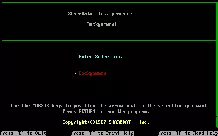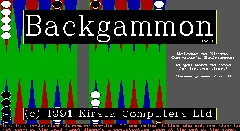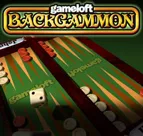Backgammon
Moby ID: 164771
See Also
- Backgammon (1974 on Terminal)
- Backgammon (1975 on Terminal)
- Backgammon (1976 on Altair 8800)
- Backgammon (1978 on TRS-80)
-
 Backgammon
(1978 on
TRS-80)
Backgammon
(1978 on
TRS-80)
- Backgammon (1978 on Commodore PET/CBM)
- Backgammon (1979 on Commodore PET/CBM)
- Backgammon (1979 on Interact Model One)
- Backgammon (1979 on Commodore PET/CBM)
-
 Backgammon
(1979 on
Atari 2600)
Backgammon
(1979 on
Atari 2600)
-
 Backgammon
(1979 on
TRS-80,
Commodore PET/CBM)
Backgammon
(1979 on
TRS-80,
Commodore PET/CBM)
- Backgammon (1979 on Commodore PET/CBM)
-
 Backgammon
(1979 on
Ohio Scientific)
Backgammon
(1979 on
Ohio Scientific)
-
 Backgammon
(1980 on
Mainframe)
Backgammon
(1980 on
Mainframe)
- Backgammon (1980 on Mainframe, Sol-20)
- Backgammon (1980 on TI Programmable Calculator)
-
 Backgammon
(1982 on
ZX81, 1983 on
ZX Spectrum)
Backgammon
(1982 on
ZX81, 1983 on
ZX Spectrum)
-
 Backgammon
(1982 on
VIC-20,
BBC Micro)
Backgammon
(1982 on
VIC-20,
BBC Micro)
-
 Backgammon
(1982 on
ZX Spectrum, 1985 on
Amstrad CPC)
Backgammon
(1982 on
ZX Spectrum, 1985 on
Amstrad CPC)
-
 Backgammon
(1982 on
DOS)
Backgammon
(1982 on
DOS)
- Backgammon (1982 on Odyssey 2)
- Backgammon (1982 on Philips P2000)
-
 Backgammon
(1983 on
Colour Genie)
Backgammon
(1983 on
Colour Genie)
- Backgammon (1983 on Dragon 32/64)
-
 Backgammon
(1983 on
Dragon 32/64)
Backgammon
(1983 on
Dragon 32/64)
- Backgammon (1983 on ZX Spectrum)
-
 Backgammon
(1984 on
MSX)
Backgammon
(1984 on
MSX)
-
 Backgammon
(1984 on
MSX)
Backgammon
(1984 on
MSX)
-
 Backgammon
(1984 on
Philips VG 5000)
Backgammon
(1984 on
Philips VG 5000)
-
 Backgammon
(1985 on
DOS)
Backgammon
(1985 on
DOS)
-
 Backgammon
(1986 on
DOS)
Backgammon
(1986 on
DOS)
-
 Backgammon
(1987 on
DOS)
Backgammon
(1987 on
DOS)
-
 Backgammon
(1987 on
DOS)
Backgammon
(1987 on
DOS)
-
 Backgammon
(1988 on
Atari ST)
Backgammon
(1988 on
Atari ST)
-
 Backgammon
(1989 on
DOS)
Backgammon
(1989 on
DOS)
-
 Backgammon
(1990 on
NES)
Backgammon
(1990 on
NES)
-
 Backgammon
(1990 on
Windows 16-bit)
Backgammon
(1990 on
Windows 16-bit)
-
 Backgammon
(1991 on
DOS)
Backgammon
(1991 on
DOS)
-
 Backgammon
(1991 on
CD-i)
Backgammon
(1991 on
CD-i)
-
 Backgammon
(1991 on
Amiga)
Backgammon
(1991 on
Amiga)
-
 Backgammon
(1995 on
Windows 16-bit)
Backgammon
(1995 on
Windows 16-bit)
- Backgammon (1998 on Browser)
- Backgammon (1999 on Game Boy Color)
-
 Backgammon
(2000 on
Windows)
Backgammon
(2000 on
Windows)
-
 Backgammon
(2007 on
J2ME, 2011 on
BlackBerry)
Backgammon
(2007 on
J2ME, 2011 on
BlackBerry)
-
 Backgammon
(2008 on
iPhone, 2012 on
iPad, 2015 on
Android)
Backgammon
(2008 on
iPhone, 2012 on
iPad, 2015 on
Android)
-
 Backgammon
(2009 on
Nintendo DS)
Backgammon
(2009 on
Nintendo DS)
-
 Backgammon
(2017 on
Linux,
Windows,
Macintosh)
Backgammon
(2017 on
Linux,
Windows,
Macintosh)
Description
Backgammon is a computer version of the classic board game. The game can be played with two players or one player versus the computer. Players roll the dice and use their two values to move chips around the board in an attempt to bear off all chips from the board before the opponent does so.
Groups +
Reviews
Critics
Analytics
Identifiers +
Contribute
Are you familiar with this game? Help document and preserve this entry in video game history! If your contribution is approved, you will earn points and be credited as a contributor.
Contributors to this Entry
Game added by vedder.
Game added May 15, 2021. Last modified April 13, 2023.










